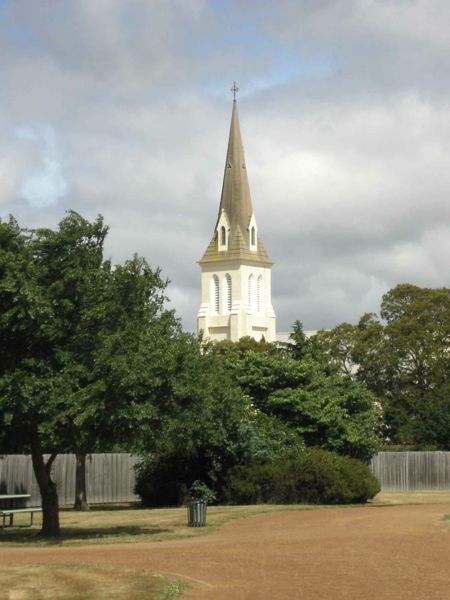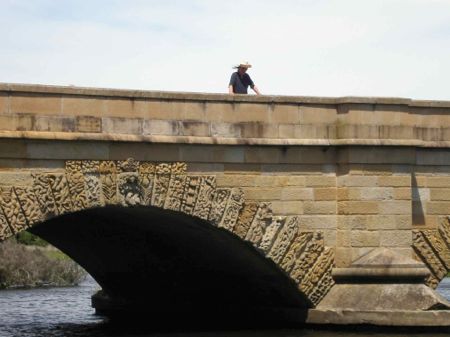Clarendon House > George Town


On Sunday morning, once breakfast was out of the way, we had time for a brief stroll around the grounds, the surrounding outbuildings, including a dairy, a butcher's shop, a bakehouse, a large stable, a gardener's cottage and a walled inner garden. Once that was out of the way, we retraced our steps to Evandale since Madam wanted to take a walk through the Sunday Markets.

Evandale is a classified historic town with superb heritage buildings in what looks to be pretty close to original condition. Once we’d completed a lap round the markets, we headed along the main street, past well preserved cottages (one with a magnificent display of lavender along the front fence), antique galleries and art and craft shops before hoofing it back to the vehicle for a short excursion in search of a historic bridge or two.
We stopped briefly in Campbell Town, but since the bridge was a fair step away from where we’d parked the car we decided to head on towards Ross and check the bridge out on the return journey.
The main road between Hobart and Launceston by-passes Ross but, turning off the highway we came to the third highlight of the previous twenty-four hours.
It definitely seems that Ross has not been greatly effected by modern tourism. The town is beautifully preserved and while we were by no means the only tourists rubbernecking round the relics there was plenty of elbow room.


What brought most of them to Ross was, of course, the convict-built stone bridge dating back to 1836. It might be the third oldest bridge still in use in Australia, but the real highlight is the the intricate carved work on both sides of the bridge. Simply spectacular. No wonder they won convict stonemason Daniel Herbert a free pardon from his sentence.
After a lengthy wander round the village the subject of lunch was broached and the simplest option seemed to be a scallop pie from the bakery - an option that we’d heartily recommend to anyone else visiting the vicinity.
With lunch duly out of the way we headed back northwards, and decided not to worry too much about the bridge at Campbell Town since Someone wanted to check out the National Rose Garden on the banks of the Macquarie River at Woolmers Estate in Longford.


A quick check of the options available persuaded us to try the self-guided tour of the grounds which, in addition to the Rose Garden and the traditional Kitchen Garden, also takes in the working horse stables, blacksmith shop, shearing shed, cider house and the coach house. The Rose Garden covers about two hectares and apparently covers the evolution of the rose, from the 18th and 19th centuries to the present. While I’ve got to admit that roses don’t do a great deal for me, any ensuing boredom was more than compensated for by the stroll around the historic buildings - again, simply magnificent and a fourth highlight of the preceding twenty-four hours.
So, in less than a day we’d encountered Clarendon House, Evandale, Ross and Woolmers Estate, and I was looking forward to the overnight stop at George Town, which I’d been led to believe is one of Tasmania's most important historic townships.
It took us a bit less than an hour to wend our way from Woolmers through Launceston and along the East Tamar Highway to the outskirts of George Town which turned out to be an administrative centre driven by industrial development rather than the historic village I’d been expecting.
On the way we’d diverted briefly to Three Wishes Winery, partly because it was more or less on the way, partly because, as far as I could gather, it was only open on weekends but mostly because I was after something to drink after dinner that night.
Like most of the wineries we subsequently visited there were only a handful of wines on offer, and baggage limits ruled out large purchases but, I decided as I worked my way through the options on offer, if this was any indication of what lay in store we were in for a very good time indeed.
In the end I opted for a bottle of the Land Bridge Pinot Noir, mainly because I thought that a red was a better post-prandial option though I would have loved to have had the option of buying an extra couple of bottles if we weren’t limited by time, budget and baggage constraints. The Riesling, in particular, is worth going back for.

Our accommodation in George Town was a cottage at 'The Grove', an elegant stone house built in 1829 and once we’d checked in, we discovered that the only historic walk option comprised a lengthy walk around various sites scattered through what was, in essence, a bit of suburbia. If we hadn’t experienced the aforementioned four highlights of the preceding twenty-four hours, we might have been inclined to follow the guidebook but opted for a drive out to Low Head instead.
It was after five when we pulled into the pilot station (the oldest continuously used pilot station in Australia, in use since 1835), so we didn’t get a chance to check out the Maritime Museum which includes items salvaged from shipwrecks off the coast, but after a walk down to the water side it was back into the car and off towards the lighthouse, which was built in 1888 to replace the original structure erected by convicts in the 1830s.
From the lighthouse there’s a reasonable view across Bass Strait, but hunger pangs were starting to set in, so we didn’t waste much time heading back to the Grove, then hoofing it a block or so to the Pier Hotel for dinner, which we started with half a dozen oysters kilpatrick.
Madam had been generous enough to pass me the oysters from the previous night’s seafood tasting platter (I’d had the steak dish) which were quite superb au naturel. While there was nothing wrong with the kilpatrick, in hindsight we should have gone for the unadorned option. Returning to the cottage we continued the process of converting a pair of Pinot-sceptics, a process which continued once we hit the wine trail the following morning.

